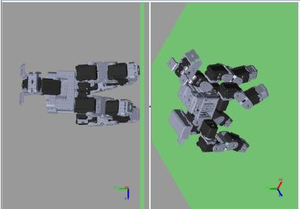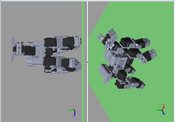Information
- Publication Type: Master Thesis
- Workgroup(s)/Project(s):
- Date: November 2020
- Date (Start): 20. October 2020
- Date (End): 26. November 2020
- TU Wien Library:
- Diploma Examination: 26. November 2020
- Open Access: yes
- First Supervisor: Eduard Gröller
- Pages: 108
- Keywords: robotic motion analysis, visualization
Abstract
The control of legged robots and teaching robotic hands to grasp are still challenging tasks. Machine learning approaches already work well in simulation. However, the discrepancy between simulation and reality sometimes causes diÿculties when applying simulation results to the real robot. Learning algorithms also require a huge amount of training data. The goal of this work is to build a sandbox that provides a detailed comparison between simulated and real-world robots and o˙ers a way of controlled and continuous data collection and exploration. The sandbox consists of a motion capture and a simulation component. The motion capture component is responsible for the continuous data collection and is realized with a system from OptiTrack with six high-precision infrared cameras. The simulation com-ponent is realized with Simulink and the Simscape Multibody Library. This component is responsible for the exploration and comparison of simulated data with real-world data. The robot that is selected for this work is a small four-legged puppy robot from ROBOTIS that is actuated with 15 Dynamixel servomotors. To integrate the robot into the sandbox, the robot’s controller is reprogrammed to make a transfer from motion data to the robot easier and to control the robot remotely. The robot is programmed with a straight walking gait and equipped with reflective markers to track its movements. With the computer-aided design (CAD) software SolidWorks, a 3D model of the puppy robot is constructed that is used for simulation in Simulink. The result is a system that accurately gathers 6 degrees of freedom (DOF) data of a small robot. This data is transferred to the simulation and can be compared to simulated data. Data from the simulation can also be tested easily on the real robot and tracked again. This way, a closed-loop system is provided for iterative robot exploration. Two datasets are compared with the help of the resulting sandbox: A dataset from ROBOTIS containing ideal joint angles for the robot, and a dataset that is obtained with the motion capture system, containing tracked joint angles. The datasets are simulated and the position and orientation of the robot are compared to the data from the motion capture. Despite strong variations in the simulated results, the simulated robot kept a similar direction and was only a few centimetres o˙ from the real robot.Additional Files and Images
Weblinks
BibTeX
@mastersthesis{Brandstaetter2020,
title = "Building a Sandbox Towards Investigating the Behavior of
Control Algorithms and Training of Real-World Robots",
author = "Klara Brandst\"{a}tter",
year = "2020",
abstract = "The control of legged robots and teaching robotic hands to
grasp are still challenging tasks. Machine learning
approaches already work well in simulation. However, the
discrepancy between simulation and reality sometimes causes
diÿculties when applying simulation results to the real
robot. Learning algorithms also require a huge amount of
training data. The goal of this work is to build a sandbox
that provides a detailed comparison between simulated and
real-world robots and o˙ers a way of controlled and
continuous data collection and exploration. The sandbox
consists of a motion capture and a simulation component. The
motion capture component is responsible for the continuous
data collection and is realized with a system from OptiTrack
with six high-precision infrared cameras. The simulation
com-ponent is realized with Simulink and the Simscape
Multibody Library. This component is responsible for the
exploration and comparison of simulated data with real-world
data. The robot that is selected for this work is a small
four-legged puppy robot from ROBOTIS that is actuated with
15 Dynamixel servomotors. To integrate the robot into the
sandbox, the robot’s controller is reprogrammed to make a
transfer from motion data to the robot easier and to control
the robot remotely. The robot is programmed with a straight
walking gait and equipped with reflective markers to track
its movements. With the computer-aided design (CAD) software
SolidWorks, a 3D model of the puppy robot is constructed
that is used for simulation in Simulink. The result is a
system that accurately gathers 6 degrees of freedom (DOF)
data of a small robot. This data is transferred to the
simulation and can be compared to simulated data. Data from
the simulation can also be tested easily on the real robot
and tracked again. This way, a closed-loop system is
provided for iterative robot exploration. Two datasets are
compared with the help of the resulting sandbox: A dataset
from ROBOTIS containing ideal joint angles for the robot,
and a dataset that is obtained with the motion capture
system, containing tracked joint angles. The datasets are
simulated and the position and orientation of the robot are
compared to the data from the motion capture. Despite strong
variations in the simulated results, the simulated robot
kept a similar direction and was only a few centimetres o˙
from the real robot.",
month = nov,
pages = "108",
address = "Favoritenstrasse 9-11/E193-02, A-1040 Vienna, Austria",
school = "Research Unit of Computer Graphics, Institute of Visual
Computing and Human-Centered Technology, Faculty of
Informatics, TU Wien",
keywords = "robotic motion analysis, visualization",
URL = "https://www.cg.tuwien.ac.at/research/publications/2020/Brandstaetter2020/",
}

 Master Thesis
Master Thesis Poster
Poster


